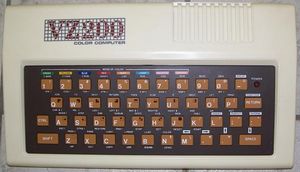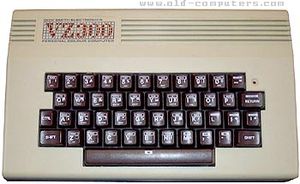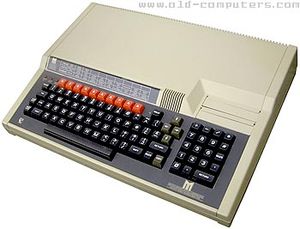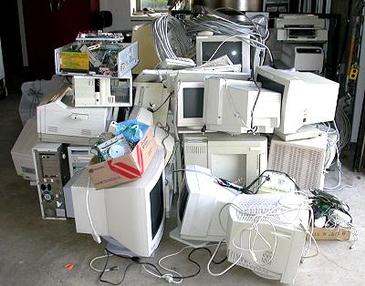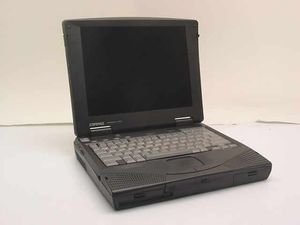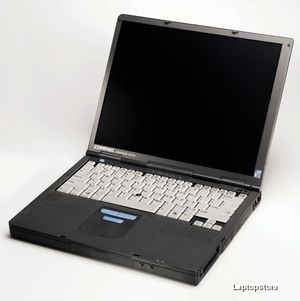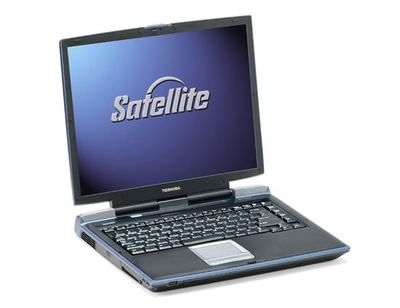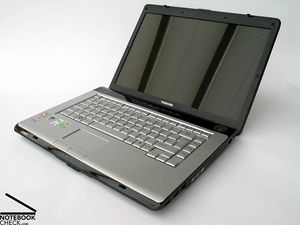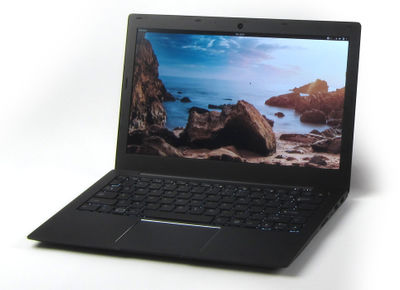Difference between revisions of "Nad/Computers"
(first laptops) |
m (Category:Retro) |
||
| (23 intermediate revisions by the same user not shown) | |||
| Line 1: | Line 1: | ||
| − | My first computer was a $200 [ | + | My first computer was a $200 [[w:VTech Laser 200|VZ-200]] which I got in about 1983. It had 8KBytes of RAM, a ROM based operating system and a [[W:Z80|Z80]] CPU running at 1MHz. Its video resolution was 128x64 pixels with four colours. |
[[File:VZ-200.jpg|300px]] | [[File:VZ-200.jpg|300px]] | ||
| Line 9: | Line 9: | ||
| − | Next in about 1987 I got a BBC master which was a 65C102 CPU (16 bit 6502 series) running at 4.77MHz, it was over $1000 and had a graphics resolution of 160x256 with 16 colours, or 640x256 with two colours. | + | Next in about 1987 I got a BBC master which was a 65C102 CPU (16 bit version of the [[w:6502|6502]] series) running at 4.77MHz, it was over $1000 and had a graphics resolution of 160x256 with 16 colours, or 640x256 with two colours. |
[[File:BBCmaster.jpg|300px]] | [[File:BBCmaster.jpg|300px]] | ||
| − | Then in 1989 my parents got me a serious computer for almost $3000! the Acorn Archimedes A3000 - this computer had serious grunt! | + | Then in 1989 my parents got me a serious computer for almost $3000! the [[w:Acorn Archimedes|Acorn Archimedes A3000]] - this computer had serious grunt! an [[w:List of ARM microarchitectures|ARM-1]] RISC chip running at 8MHz - equivalent in processing power to a 40MHz 386 chip, and 1MB of RAM which I upgraded a couple of years later to 4MB (at a cost of $700). I also bought my first hard drive for this computer which was a 120MB SCSI drive for $1000. The operating system [[w:RISC OS|RISC OS]] was ROM-based). |
[[File:Acorn-A3000.jpg|300px]] | [[File:Acorn-A3000.jpg|300px]] | ||
| + | In 1996 I moved reluctantly to the world of PC's starting with a no-name 75MHz Pentium running Windows 95 and then ending with a 266MHz AMD K6 before moving to laptops in 1999. I had a number of PCs running as servers as well and had an office for a couple of years with a few PCs in it. The servers were running Linux and the PCs running Windows. | ||
| − | + | [[File:Pile of PC's.jpg]] | |
| − | My first laptop was a Compaq Armada 1700 which had a 233MHz Pentium-II chip, 32MB RAM, a 5GB hard drive and a 1024x768 TFT colour screen. These machines retailed for over $10,000!!! I got mine at almost half price at $5500 for a special dealer promotion. | + | |
| + | My first laptop was a Compaq Armada 1700 which had a 233MHz Pentium-II chip, 32MB RAM, a 5GB hard drive and a 1024x768 TFT colour screen running Windows 98. These machines retailed for over $10,000!!! I got mine at almost half price at $5500 for a special dealer promotion. | ||
[[File:Compaq Armada 1700.jpg|300px]] | [[File:Compaq Armada 1700.jpg|300px]] | ||
| − | I kept this | + | I kept this trusty machine for 3 years until it was stolen in 2002 from out of our car at which time I replaced it with a similar model for $480 second-hand off TradeMe, a Compaq Armada E700 which was a 450MHz Pentium-III with a 12GB hard drive and 128MB RAM running Windows 2000. |
[[File:Compaq Armada E700.jpg|300px]] | [[File:Compaq Armada E700.jpg|300px]] | ||
| − | In 2005 I got a Toshiba Satellite A10, it was a 2200MHz Celeron with 256MB RAM and 30GB hard disk. In 2006 I installed Ubuntu 6.04 on this machine which ran very well. | + | In 2005 I got a Toshiba Satellite A10 for $1650, it was a 2200MHz Celeron with 256MB RAM and 30GB hard disk. In 2006 I replaced the hard-drive with a 160GB and installed Ubuntu 6.04 on this machine which ran very well. This is when I first changed over from Windows to Linux for my desktop operating system, and I've never looked back since! |
[[File:Toshiba Satellite A10.jpg|400px]] | [[File:Toshiba Satellite A10.jpg|400px]] | ||
| + | |||
| + | |||
| + | In 2008 after my good experience running Linux on Toshiba I decided to stick with them for my next laptop and got a Satellite A210 for $1100. Big mistake! This is the most Linux unfriendly machine I've ever had and it turned me off Toshiba for ever!!! After wrestling with incompatibilities for a couple of months I flicked it on TradeMe for just under $900. | ||
| + | |||
| + | [[File:Toshiba Satellite A210.jpg|300px]] | ||
| + | |||
| + | |||
| + | I then decided to change to a Dell since they had a reputation for being very Linux friendly. I got a second-hand [[Dell XPS M1330]] which ran Linux perfectly and I was very happy with. It was $1350 second-hand and had a 320GB hard-drive, 4GB of RAM a 2.4GHz Core2 Duo CPU and a 1280x800 screen. | ||
| + | |||
| + | [[File:Dell XPS m1330.jpg|400px]] | ||
| + | |||
| + | |||
| + | In August 2011 my most recent computer which I've just got is a new Dell Inspiron 13z for $1000 which is a Dual 2.2GHz Core i5 CPU (4 threads) with 4GB of RAM and a 320GB hard-drive. I booted straight into an Ubuntu 11.04 memory stick so that it never had to have the misfortune of experiencing a Windows operating system! Everything worked perfectly on Ubuntu out of the box including Wifi, Bluetooth, Webcam and Standby/Resume :-) A year or so later the hard-drive started corrupting (to be fair I had dropped the computer on the floor while it was running), so I decided to move over to solid state. I got a 120GB Samsung 840 series and also upgraded the RAM to 8GB and changed my OS over to Debian 7. | ||
| + | |||
| + | [[File:Dell Inspiron 13z.jpg|400px]] | ||
| + | |||
| + | At the end of 2013 the Inspiron started having trouble. First the battery stopped working even though it still had over two hours of charge, then the keyboard started having intermittent problems. I decided it was that time again and started looking for a new one. This time I wanted to have one that worked well both as a normal laptop and as a tablet, but also had reasonable power and would run Linux well. After searching around through numerous reviews I settled on a [[Samsung ATIV Smart PC Pro (XE700T1C)]] which is the same dual core i5 as the Inspiron had, 4GB of RAM, a 120GB SSD and an 11.6" 1920x1080 pixel touch-screen. I had to change OS again because the stable versions of Debian and Ubuntu didn't have a recent enough kernel to support the touch screen properly, but [http://www.linuxmint.com Linux Mint 16] worked out nicely. | ||
| + | {| | ||
| + | |[[File:XE700T1C-2.jpg|400px]] | ||
| + | | | ||
| + | |[[File:XE700T1C-1.jpg]] | ||
| + | |} | ||
| + | |||
| + | In the second half of 2017 the Sammy started having problems, first it wouldn't go onto stand-by properly, it would take ten seconds or so and then the power indicator would show that it hadn't actually powered down, so I'd have to then resume it again, and then stand-by again which would take about thirty seconds! Next, the screen got a bad connection which meant I had to keep pressing and bending the unit to try and get the screen working all the time. I tried to get it fixed, but nobody could do it because it required special Samsung glue, and Samsung themselves would only replace the screen which cost more than the unit was worth at that point. | ||
| + | |||
| + | So it was time for a new one again! This time I found an awesome place called [http://puri.sm Purism] which are crowd-funded and do things the way the community want them, for example, no built-in obsolescence, all standard plugs, easy to modify, no slave labour in the fabrication, physical disabling of the camera and microphone. It cost a bit more, but I'm really happy to pay more to say YES to awesome stuff made the way we want it, and NO to all the oppressive corporate bullshit! Also we were able to pay in [[Bitcoin]] :-) Beth and I both got a [https://puri.sm/products/librem-13/ Librem 13] each, upgraded to a super fast 500GB solid-state drive, 8GB of RAM and dual-core quad-thread i7 CPU. | ||
| + | |||
| + | [[File:Librem-13.jpg|400px]] | ||
| + | |||
| + | == See also == | ||
| + | *[http://www.nzherald.co.nz/business/news/article.cfm?c_id=3&objectid=11569422 Dick Smith Electronics goes under] ''- this is where I got my first computers from'' | ||
| + | *[http://arstechnica.co.uk/gadgets/2016/01/lenovo-x1-carbon-adds-tablet-and-desktop-editions-and-a-yoga-that-ditches-the-lcd/ Next lappie?] | ||
| + | [[Category:Retro]] | ||
Latest revision as of 15:31, 16 September 2018
My first computer was a $200 VZ-200 which I got in about 1983. It had 8KBytes of RAM, a ROM based operating system and a Z80 CPU running at 1MHz. Its video resolution was 128x64 pixels with four colours.
A couple of years later I upgraded to a VZ-300 for about $300. This one had 16K of RAM and ran at 3.54MHz!
Next in about 1987 I got a BBC master which was a 65C102 CPU (16 bit version of the 6502 series) running at 4.77MHz, it was over $1000 and had a graphics resolution of 160x256 with 16 colours, or 640x256 with two colours.
Then in 1989 my parents got me a serious computer for almost $3000! the Acorn Archimedes A3000 - this computer had serious grunt! an ARM-1 RISC chip running at 8MHz - equivalent in processing power to a 40MHz 386 chip, and 1MB of RAM which I upgraded a couple of years later to 4MB (at a cost of $700). I also bought my first hard drive for this computer which was a 120MB SCSI drive for $1000. The operating system RISC OS was ROM-based).
In 1996 I moved reluctantly to the world of PC's starting with a no-name 75MHz Pentium running Windows 95 and then ending with a 266MHz AMD K6 before moving to laptops in 1999. I had a number of PCs running as servers as well and had an office for a couple of years with a few PCs in it. The servers were running Linux and the PCs running Windows.
My first laptop was a Compaq Armada 1700 which had a 233MHz Pentium-II chip, 32MB RAM, a 5GB hard drive and a 1024x768 TFT colour screen running Windows 98. These machines retailed for over $10,000!!! I got mine at almost half price at $5500 for a special dealer promotion.
I kept this trusty machine for 3 years until it was stolen in 2002 from out of our car at which time I replaced it with a similar model for $480 second-hand off TradeMe, a Compaq Armada E700 which was a 450MHz Pentium-III with a 12GB hard drive and 128MB RAM running Windows 2000.
In 2005 I got a Toshiba Satellite A10 for $1650, it was a 2200MHz Celeron with 256MB RAM and 30GB hard disk. In 2006 I replaced the hard-drive with a 160GB and installed Ubuntu 6.04 on this machine which ran very well. This is when I first changed over from Windows to Linux for my desktop operating system, and I've never looked back since!
In 2008 after my good experience running Linux on Toshiba I decided to stick with them for my next laptop and got a Satellite A210 for $1100. Big mistake! This is the most Linux unfriendly machine I've ever had and it turned me off Toshiba for ever!!! After wrestling with incompatibilities for a couple of months I flicked it on TradeMe for just under $900.
I then decided to change to a Dell since they had a reputation for being very Linux friendly. I got a second-hand Dell XPS M1330 which ran Linux perfectly and I was very happy with. It was $1350 second-hand and had a 320GB hard-drive, 4GB of RAM a 2.4GHz Core2 Duo CPU and a 1280x800 screen.
In August 2011 my most recent computer which I've just got is a new Dell Inspiron 13z for $1000 which is a Dual 2.2GHz Core i5 CPU (4 threads) with 4GB of RAM and a 320GB hard-drive. I booted straight into an Ubuntu 11.04 memory stick so that it never had to have the misfortune of experiencing a Windows operating system! Everything worked perfectly on Ubuntu out of the box including Wifi, Bluetooth, Webcam and Standby/Resume :-) A year or so later the hard-drive started corrupting (to be fair I had dropped the computer on the floor while it was running), so I decided to move over to solid state. I got a 120GB Samsung 840 series and also upgraded the RAM to 8GB and changed my OS over to Debian 7.
At the end of 2013 the Inspiron started having trouble. First the battery stopped working even though it still had over two hours of charge, then the keyboard started having intermittent problems. I decided it was that time again and started looking for a new one. This time I wanted to have one that worked well both as a normal laptop and as a tablet, but also had reasonable power and would run Linux well. After searching around through numerous reviews I settled on a Samsung ATIV Smart PC Pro (XE700T1C) which is the same dual core i5 as the Inspiron had, 4GB of RAM, a 120GB SSD and an 11.6" 1920x1080 pixel touch-screen. I had to change OS again because the stable versions of Debian and Ubuntu didn't have a recent enough kernel to support the touch screen properly, but Linux Mint 16 worked out nicely.
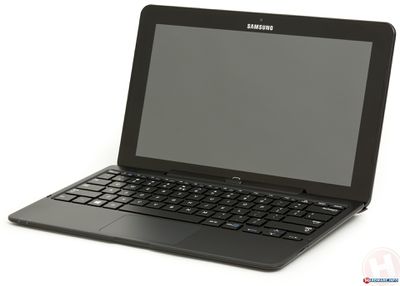
|
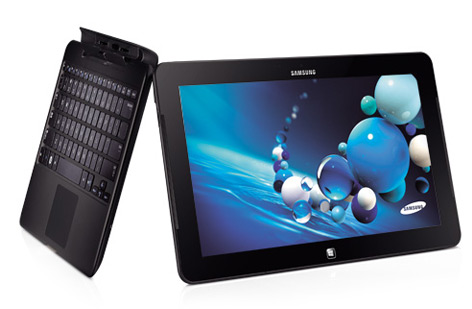
|
In the second half of 2017 the Sammy started having problems, first it wouldn't go onto stand-by properly, it would take ten seconds or so and then the power indicator would show that it hadn't actually powered down, so I'd have to then resume it again, and then stand-by again which would take about thirty seconds! Next, the screen got a bad connection which meant I had to keep pressing and bending the unit to try and get the screen working all the time. I tried to get it fixed, but nobody could do it because it required special Samsung glue, and Samsung themselves would only replace the screen which cost more than the unit was worth at that point.
So it was time for a new one again! This time I found an awesome place called Purism which are crowd-funded and do things the way the community want them, for example, no built-in obsolescence, all standard plugs, easy to modify, no slave labour in the fabrication, physical disabling of the camera and microphone. It cost a bit more, but I'm really happy to pay more to say YES to awesome stuff made the way we want it, and NO to all the oppressive corporate bullshit! Also we were able to pay in Bitcoin :-) Beth and I both got a Librem 13 each, upgraded to a super fast 500GB solid-state drive, 8GB of RAM and dual-core quad-thread i7 CPU.
See also
- Dick Smith Electronics goes under - this is where I got my first computers from
- Next lappie?
